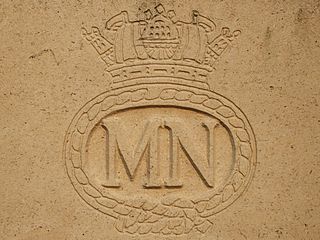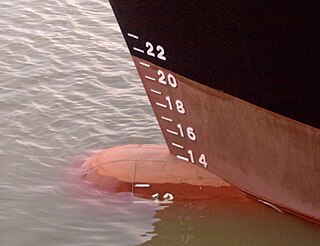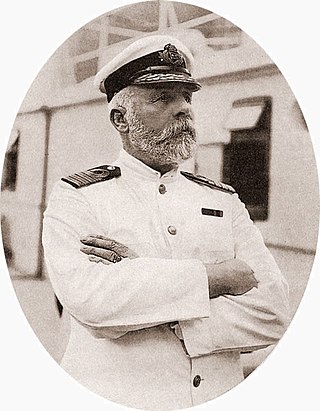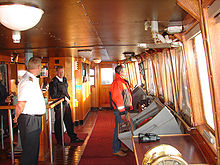
Maritime transport or more generally waterborne transport, is the transport of people (passengers) or goods (cargo) via waterways. Freight transport by sea has been widely used throughout recorded history. The advent of aviation has diminished the importance of sea travel for passengers, though it is still popular for short trips and pleasure cruises. Transport by water is cheaper than transport by air or ground, but significantly slower for longer distances. Maritime transport accounts for roughly 80% of international trade, according to UNCTAD in 2020.

Seamanship is the art, knowledge and competence of operating a ship, boat or other craft on water. The Oxford Dictionary states that seamanship is "The skill, techniques, or practice of handling a ship or boat at sea."

The United States Merchant Marine is an organization composed of United States civilian mariners and U.S. civilian and federally owned merchant vessels. Both the civilian mariners and the merchant vessels are managed by a combination of the government and private sectors, and engage in commerce or transportation of goods and services in and out of the navigable waters of the United States. The Merchant Marine primarily transports domestic and international cargo and passengers during peacetime, and operate and maintain deep-sea merchant ships, tugboats, towboats, ferries, dredges, excursion vessels, charter boats and other waterborne craft on the oceans, the Great Lakes, rivers, canals, harbors, and other waterways. In times of war, the Merchant Marine can be an auxiliary to the United States Navy, and can be called upon to deliver military personnel and materiel for the military.

The British Merchant Navy is the collective name given to British civilian ships and their associated crews, including officers and ratings. In the UK, it is simply referred to as the Merchant Navy or MN. Merchant Navy vessels fly the Red Ensign and the ships and crew are regulated by the Maritime and Coastguard Agency (MCA), a specialist agency of the UK Department of Transport. British merchant ships are registered under the UK or Red Ensign group ship registries. British Merchant Navy deck officers and ratings are certificated and trained according to STCW Convention and the syllabus of the Merchant Navy Training Board in maritime colleges and other training institutes around the UK.
A bareboat charter, or demise charter, is an arrangement for the chartering or hiring of a ship or boat for which no crew or provisions are included as part of the agreement. Instead, the people who rent the vessel from the owner are responsible for taking care of such things. The act is commonly known as bareboating or bareboat charter.

USS Cyclops (AC-4) was the second of four Proteus-class colliers built for the United States Navy several years before World War I. Named after the Cyclops, a race of giants from Greek mythology, she was the second U.S. naval vessel to bear the name. The loss of the ship and 306 crew and passengers without a trace sometime after 4 March 1918 remains the single largest loss of life in the history of the United States Navy not directly involving combat.

Deadweight tonnage or tons deadweight (DWT) is a measure of how much weight a ship can carry. It is the sum of the weights of cargo, fuel, fresh water, ballast water, provisions, passengers, and crew.

A chief mate (C/M) or chief officer, usually also synonymous with the first mate or first officer, is a licensed mariner and head of the deck department of a merchant ship. The chief mate is customarily a watchstander and is in charge of the ship's cargo and deck crew. The actual title used will vary by ship's employment, by type of ship, by nationality, and by trade: for instance, chief mate is not usually used in the Commonwealth, although chief officer and first mate are; on passenger ships, the first officer may be a separate position from that of the chief officer that is junior to the latter.
A second mate or second officer (2/O) is a licensed member of the deck department of a merchant ship holding a Second Mates Certificate of Competence, by an authorised governing state of the International Maritime Organization (IMO). The second mate is the third in command and a watchkeeping officer, customarily the ship's navigator. Other duties vary, but the second mate is often the medical officer and in charge of maintaining distress signaling equipment. On oil tankers, the second mate usually assists the chief mate with the cargo operations.

A third mate (3/M) or third officer is a licensed member of the deck department of a merchant ship. The third mate is a watchstander and customarily the ship's safety officer and fourth-in-command. The position is junior to a second mate. Other duties vary depending on the type of ship, its crewing, and other factors.
Seafaring is a tradition that encompasses a variety of professions and ranks. Each of these roles carries unique responsibilities that are integral to the successful operation of a seafaring vessel. A ship's crew can generally be divided into four main categories: the deck department, the engineering department, the steward's department, and other. The reasoning behind this is that a ship's bridge, filled with sophisticated navigational equipment, requires skills differing from those used on deck operations – such as berthing, cargo and/or military devices – which in turn requires skills different from those used in a ship's engine room and propulsion, and so on.
A shipowner, ship owner or ship-owner is the owner of a ship. They can be merchant vessels involved in the shipping industry or non commercially owned. In the commercial sense of the term, a shipowner is someone who equips and exploits a ship, usually for delivering cargo at a certain freight rate, either as a per freight rate or based on hire. Shipowners typically hire a licensed crew and captain rather than take charge of the vessel in person. Usually the shipowner is organized through a company, but also people and investment funds can be shipowners. If owned by a ship company, the shipowner usually performs technical management of the vessel through the company, though this can also be outsourced or relayed onto the shipper through bareboat charter.

The displacement or displacement tonnage of a ship is its weight. As the term indicates, it is measured indirectly, using Archimedes' principle, by first calculating the volume of water displaced by the ship, then converting that value into weight. Traditionally, various measurement rules have been in use, giving various measures in long tons. Today, tonnes are more commonly used.
A master mariner is a licensed mariner who holds the highest grade of seafarer qualification; namely, an unlimited master's license. Such a license is labelled unlimited because it has no limits on the tonnage, power, or geographic location of the vessel that the holder of the license is allowed to serve upon. A master mariner would therefore be allowed to serve as the master of a merchant ship of any size, of any type, operating anywhere in the world, and it reflects the highest level of professional qualification amongst mariners and deck officers.

The Friendship of Salem is a 171-foot replica of the Friendship, a 1797 East Indiaman. It was built in 2000 in the Scarano Brothers Shipyard in Albany, New York. The ship usually operates as a stationary museum ship during most of the year. However, it is a fully functioning United States Coast Guard-certified vessel capable of passenger and crew voyages, which makes special sailings during various times of the year. The Friendship of Salem is docked at the Salem Maritime National Historic Site, established in 1938 as the first such site in the United States. The site, which includes several structures, artifacts and records, is operated by the National Park Service.

"The captain goes down with the ship" is a maritime tradition that a sea captain holds the ultimate responsibility for both the ship and everyone embarked on it, and in an emergency they will devote their time to save those on board or die trying. Although often connected to the sinking of RMS Titanic in 1912 and its captain, Edward Smith, the tradition precedes Titanic by several years. In most instances, captains forgo their own rapid departure of a ship in distress, and concentrate instead on saving other people. It often results in either the death or belated rescue of the captain as the last person on board.

RMS Lady Hawkins was a steam turbine ocean liner. She was one of a class of five sister ships popularly known as "Lady Boats" that Cammell Laird of Birkenhead, England built in 1928 and 1929 for the Canadian National Steamship Company. The five vessels were Royal Mail Ships that CN operated from Halifax, Nova Scotia and the Caribbean via Bermuda. In 1942 the German submarine U-66 sank Lady Hawkins in the North Atlantic, killing 251 of the 322 people aboard.

The SS Brainerd Victory was a Victory-class cargo ship built during World War II.

Tejuca was a small 470-ton clipper ship built in Hoboken, New Jersey in 1854. After only eighteen months of service, she was lost in a hurricane on the North Atlantic, with most of her crew rescued through a daring maneuver carried out by the ship Excelsior.
Nautical operations refers to the crew operation of a ship. It is the term used in academic education to refer to the studies of this professional field. Nautical operations refers to all the operational procedures, specific roles of officers and crew members, and regular functions and technical processes, which together shape the structure and functions for the general operations of a ship.


















